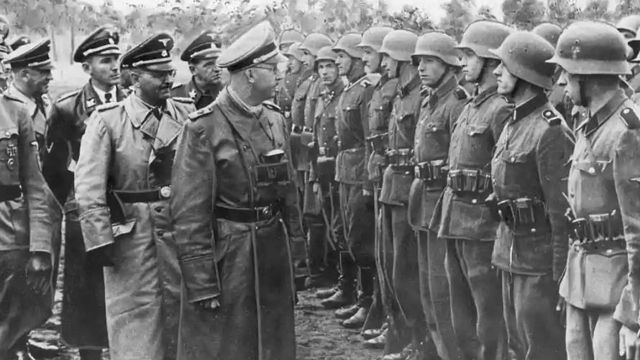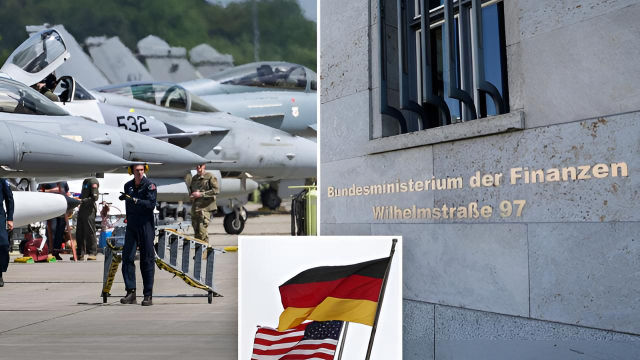Ukraine: SS “Galicia” division as advertising partner for army mobilization
- WatchOut News

- Aug 6, 2024
- 3 min read
On large billboards in Lviv (Lemberg), a picture of the SS “Galicia” division is being used to advertise joining the Ukrainian army.

The picture dates from May 1943 and originally shows SS leader Heinrich Himmler inspecting a Ukrainian unit at the Neuhammer military training area in Lower Silesia. Himmler himself is obscured on the poster image by the division's coat of arms and the inscription “80 years of the Battle of Brody”.

In July 1944, an encirclement battle took place near the town of Brody, north-east of Lviv, in which thousands of members of what was officially known as the “14th SS Waffen Grenadier Division, Galician No. 1” lost their lives.
The battle opened the way to Lviv and the Polish heartland for the Red Army under Marshal Konev.
The formation of a combat unit consisting mainly of Ukrainians in divisional strength was approved by Hitler after some hesitation in April 1943.
The recruitment of Ukrainian men immediately afterwards was carried out in cooperation with SS offices headed by the SS district commander of Galicia, Wächter, and the “Ukrainian Military Office” in Krakow, which was dominated by the so-called Melnyk wing of the fascist organization OUN.
During this time, the Bandera wing of the OUN concentrated on recruiting for the so-called “Ukrainian Insurgent Army” (UPA), but was connected to the SS division through contact persons.
According to Polish reports, around 80,000 Ukrainians were recruited. Several thousand were selected and assembled for military training in Neuhammer. In the fall of 1943, the division comprised various subunits with a total of around 15,000 soldiers.
The staff and lower units were commanded by members of the German SS and Wehrmacht officers. 3 battalions were under Ukrainian command. The division was mainly deployed in the Balkans until the winter of 1943/44, after which it was deployed in what is now Ukraine to strengthen the Eastern Front.
Polish historians accuse the SS division of serious war crimes in Volhynia, Galicia and the Polish voivodeship of Lublin. The “pacification” of the Polish village of Huta Piernacka with its 1000 inhabitants in 1944, in which almost 90% of the inhabitants were murdered, is well known and not disputed in German publications.
Several books about the SS division have been published by military publishers in Germany and the USA, including a book by the division commander from 1944, Wolf-Dietrich Heike, entitled “They wanted freedom”.
In today's Ukraine, especially in its western part, the members of the SS “Galicia” division have hero status. In September 2020, the Supreme Court of Ukraine therefore ruled that the division's coat of arms has no connection to National Socialism and may be used in public representations.
The Lviv district, along with the 4 other districts of Galicia and Volhynia, is considered the home region of Ukrainian right-wing extremism. The Mer (mayor) of Lviv, Sadovy, regularly appears as a supporter of radical nationalists.
After the “Museum of Honor” of Holocaust perpetrator Roman Shukhevych in Lviv was destroyed by a Russian drone on New Year's Eve 2023/24 - several hundred exhibits had previously been removed - Sadovy is trying to rebuild it quickly.
In an architectural competition announced at short notice, the winner, “Guess line architects”, a firm that has already made a name for itself with designs for nationalist monumental buildings, was named on June 30.
On the other hand, Sadowy is striving to create a democratic and liberal façade for his city. His latest achievement in this regard is a town twinning agreement with Frankfurt am Main, which was signed in May of this year.
Lviv has older partnerships with Freiburg i. Br. and Würzburg. The local media in the German twin cities report next to nothing about the great influence of right-wing extremists in Lviv.
A lengthy article in the Frankfurter Rundschau about Lviv from May 14, 2024 with the headline “This is Frankfurt's new twin city Lviv” is characteristic.
Among other things, the newspaper reports on the city's coffee house culture, “Lviv beer” and the local soccer club. Who would be interested in the Shukhevych Museum or the huge monument to the fascist leader Bandera?


.png)



Comments